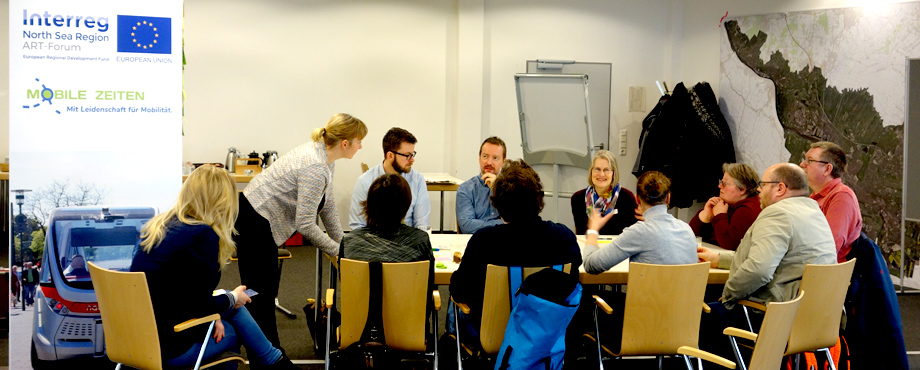ART Forum has taken a step towards to capacity building of policy makers, stakeholders, public and planners on the impacts of ART. The partner DLR (German Aerospace Center) together with the ART-Forum project lead City of Bremen invited almost 30 stakeholders on 26th February in Bremen (GER) to initiate the “Bremen dialogue on automated driving”. Mobilw Zeiten was involved as input speaker and moderator in the workshop.
What would a city of the future look like, where only fully autonomous vehicles (level 5) would drive? How would the city be shaped in terms of infrastructure, urban planning, shared spaces and the interactions between all involved modes like pedestrians, cyclists and public transport? And how would the municipalities in particular be required to (re-)act by changing the planning and political framework conditions?
With the aim of finding answers to these questions, the DLR Institute of Transport Research and Institute of Transportation Systems are applying a three-step approach that includes workshops, the derivation of parameters and simulation models. In a first step, expert-workshops will be used to identify relevant criteria, their characteristics and weighting, which are evaluated as central to urban and transport planning in order to achieve the goals of sustainable urban mobility. In a second step, these qualitatively derived criteria are transferred into parameters for transport modelling in order to incorporate them into a simulation model of a fictitious city in the third step. With the help of the simulation model, various planning elements can be tested for their effectiveness with regard to the objectives of sustainable transport.
Against this background, the DLR Institute of Transport Research in cooperation with the ART-Forum project lead City of Bremen hold a one-day expert-workshop and invited almost 30 stakeholders from civil society, science, politics, municipalities and associations of the City of Bremen, Germany.
The Expert-Workshop
After a warm welcome to everybody by DLR and the City of Bremen, Gesa Balssen and Christoph Marquart of the ART-Forum partner Mobile Zeiten gave an insight on the state of art as well as present challenges on automated driving in the city. They showed the importance of connecting people as well as challenges in accessibility, infrastructure, technology and acceptability issues in cities. Michael Glotz-Richter of the City of Bremen presented a very interesting view on autonomous driving. He led the way to an exciting discussion by pointing out both, already existing autonomous vehicles and future requirements to gain benefits in safety, land use and congestion.
The “Futures Wheel” Method
Aim of the workshop was the determine expectations of how a future city with autonomous vehicles will look like and, based on this, which regulatory intervention will be necessary to meet them. Therefore, the explorative scenario-method “Futures Wheel” method originating in Futurology was applied. The objective of this method is to visualize potential direct and indirect effects of a possible future situation and is used to structure group processes in a participatory manner. In this workshop, we used a reverse “Futures Wheel” meaning we put the vision of a possible future in the center and going reverse to explore regulatory measures and actions leading to this vision of an autonomous mobility future. As a second adjustment to the method, a total of seven impact areas – costs, mobility and travel behavior, network efficiency, public health and safety, land use, requirements and acceptance and drivers behavior – where identified as relevant in advance and used to structure the process.
The Working Phase
The basic assumption of the Workshop was the complete automation of mobility concepts and the use of active modes of urban mobility. Based on thematic criteria the participants were divided into three groups “Urban mobilists and target groups of autonomous mobility concepts”, “Framework conditions and Management”, and “Risk assessment, Standards and technological Development”. Each of these groups developed their Future Wheel with the key question at its center: “What will my city of the future look like with autonomous vehicles?” Altogether, three Futures Wheels were developed diving into topics to elaborate regulatory measures and actions in three rounds. After each of the groups developed their Future Wheel, the groups changed the tables and worked on the Futures Wheels the other groups had developed, validating and completing the respective results.
Following this very exciting and intense discussion and validation process by working on possible measures and regulatory focus from very diverse points of views, Torben Quickert of the City of Bremen and project lead of ART-Forum gave an overview of a previous study that addressed municipal perspectives on autonomous driving.
Finally, a concluding “Master”-Futures Wheel was created by putting the measures of the three Futures Wheels together and a controversial yet fruitful exchange of views and discussion in the plenum finalized the workshop.
The Follow-up
The results are currently being evaluated and further developed as a basis for upcoming workshops in several European cities together with partners of the ART-Forum project consortium.





